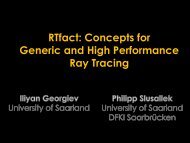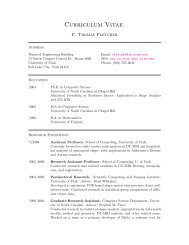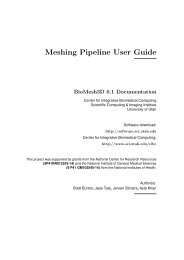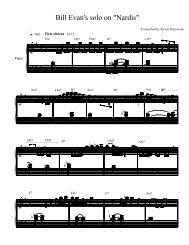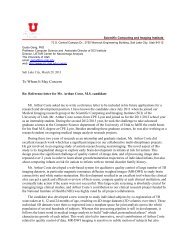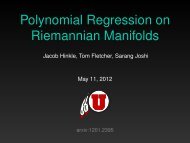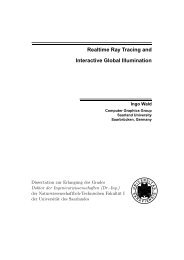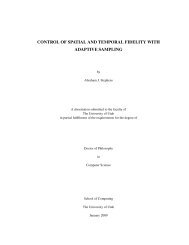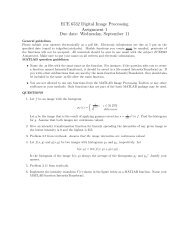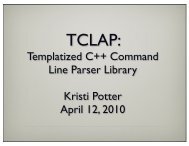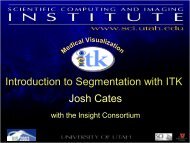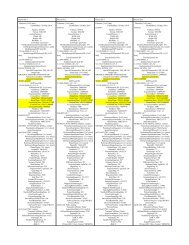SCIRun Forward/Inverse ECG Toolkit - Scientific Computing and ...
SCIRun Forward/Inverse ECG Toolkit - Scientific Computing and ...
SCIRun Forward/Inverse ECG Toolkit - Scientific Computing and ...
Create successful ePaper yourself
Turn your PDF publications into a flip-book with our unique Google optimized e-Paper software.
<strong>SCIRun</strong> <strong>Forward</strong>/<strong>Inverse</strong> <strong>ECG</strong><br />
<strong>Toolkit</strong><br />
<strong>SCIRun</strong> 4.7 Documentation<br />
Center for Integrative Biomedical <strong>Computing</strong><br />
<strong>Scientific</strong> <strong>Computing</strong> & Imaging Institute<br />
University of Utah<br />
<strong>SCIRun</strong> software download:<br />
http://software.sci.utah.edu<br />
Center for Integrative Biomedical <strong>Computing</strong>:<br />
http://www.sci.utah.edu/cibc<br />
This project was supported by grants from the National Center for Research Resources<br />
(5P41RR012553-14) <strong>and</strong> the National Institute of General Medical Sciences<br />
(8 P41 GM103545-14) from the National Institutes of Health.<br />
Author(s):<br />
Jaume Coll-Font, Moritz Dannhauer, Michael Steffen, Darrell Swenson, Dafang Wang,<br />
Burak Erem, Jess Tate, Jeroen Stinstra, Dana Brooks <strong>and</strong> Rob MacLeod
Contents<br />
1 Overview 3<br />
1.1 <strong>Toolkit</strong> overview <strong>and</strong> capabilities . . . . . . . . . . . . . . . . . . . . . . . . . 3<br />
1.2 Software requirements . . . . . . . . . . . . . . . . . . . . . . . . . . . . . . . 5<br />
1.2.1 <strong>SCIRun</strong> Compatibility . . . . . . . . . . . . . . . . . . . . . . . . . . . 5<br />
1.2.2 Required Datasets . . . . . . . . . . . . . . . . . . . . . . . . . . . . . 5<br />
2 Mathematical Background 6<br />
2.1 Overview . . . . . . . . . . . . . . . . . . . . . . . . . . . . . . . . . . . . . . 6<br />
2.2 Solutions to the <strong>Forward</strong> Problem in the <strong>Forward</strong>/<strong>Inverse</strong> <strong>Toolkit</strong> . . . . . . . 7<br />
2.2.1 FEM in the <strong>Forward</strong>/<strong>Inverse</strong> <strong>Toolkit</strong> . . . . . . . . . . . . . . . . . . . 8<br />
2.2.2 BEM in the <strong>Forward</strong>/<strong>Inverse</strong> <strong>Toolkit</strong> . . . . . . . . . . . . . . . . . . . 9<br />
2.3 Solutions to the <strong>Inverse</strong> Problem in the <strong>Forward</strong>/<strong>Inverse</strong> <strong>Toolkit</strong> . . . . . . . 10<br />
2.3.1 Activation-based <strong>Inverse</strong> Solutions in the <strong>Forward</strong>/<strong>Inverse</strong> <strong>Toolkit</strong> . . 11<br />
2.3.2 Potential-based <strong>Inverse</strong> Solutions in the <strong>Forward</strong>/<strong>Inverse</strong> <strong>Toolkit</strong> . . . 11<br />
3 <strong>Forward</strong> Solutions 15<br />
3.1 Overview . . . . . . . . . . . . . . . . . . . . . . . . . . . . . . . . . . . . . . 15<br />
3.2 Module Descriptions for Boundary Element Solutions . . . . . . . . . . . . . 16<br />
3.3 Module Descriptions for Finite Element Solutions . . . . . . . . . . . . . . . . 17<br />
3.4 Example Networks for Boundary Element Solutions . . . . . . . . . . . . . . 18<br />
3.5 Example Networks for Finite Element Solutions . . . . . . . . . . . . . . . . . 20<br />
3.5.1 Potential Based <strong>Forward</strong> FEM simulation . . . . . . . . . . . . . . . . 20<br />
3.5.2 Activation Based <strong>Forward</strong> FEM simulation . . . . . . . . . . . . . . . 25<br />
4 <strong>Inverse</strong> Solutions 27<br />
4.1 Overview . . . . . . . . . . . . . . . . . . . . . . . . . . . . . . . . . . . . . . 27<br />
4.2 Module Descriptions for <strong>Inverse</strong> Solution Methods . . . . . . . . . . . . . . . 27<br />
4.2.1 Tikhonov Regularization . . . . . . . . . . . . . . . . . . . . . . . . . . 27<br />
4.2.2 Tikhonov Singular Value Decomposition (SVD) . . . . . . . . . . . . . 30<br />
4.2.3 Truncated SVD . . . . . . . . . . . . . . . . . . . . . . . . . . . . . . . 31<br />
4.2.4 Matlab Interface . . . . . . . . . . . . . . . . . . . . . . . . . . . . . . 31<br />
4.3 Example Simulations . . . . . . . . . . . . . . . . . . . . . . . . . . . . . . . . 34<br />
4.3.1 Tikhonov Regularization . . . . . . . . . . . . . . . . . . . . . . . . . . 34<br />
4.3.2 Gauss-Newton Method . . . . . . . . . . . . . . . . . . . . . . . . . . . 36<br />
2
Chapter 1<br />
Overview<br />
This guide describes <strong>and</strong> documents the <strong>SCIRun</strong> <strong>ECG</strong> <strong>Forward</strong>/<strong>Inverse</strong> <strong>Toolkit</strong>. This toolkit is a collection<br />
of modules <strong>and</strong> networks within the <strong>SCIRun</strong> system, which can be used to solve forward <strong>and</strong><br />
inverse electrocardiography problems. The guide assumes that the reader has basic user-level familiarity<br />
with <strong>SCIRun</strong>; in particular that the reader is familiar with placing modules into a <strong>SCIRun</strong> network,<br />
connecting modules, <strong>and</strong> visualizing data. If the reader is not familiar with these operations, we suggest<br />
you first consult the <strong>SCIRun</strong> Basic Tutorial, also distributed in the <strong>SCIRun</strong> documentation.<br />
The purpose of this toolkit is to advance the state of forward <strong>and</strong> inverse solutions in this field by<br />
offering a common platform for investigators <strong>and</strong> others to compare geometries <strong>and</strong> geometric representations,<br />
forward <strong>and</strong> inverse algorithms <strong>and</strong> data, with the maximum degree of both flexibility <strong>and</strong><br />
commonality that we can achieve. Thus, we hope to increase the ”reproducibility” of developments<br />
in this field <strong>and</strong> help move these technologies closer to useful clinical applications. As such, the<br />
software (like all of <strong>SCIRun</strong>) is open-source, modular, <strong>and</strong> extensible. We follow modern open-source<br />
software engineering practices to maximize portability, extensibility, <strong>and</strong> reliability of our software.<br />
As we explain below, <strong>SCIRun</strong> has a built-in facility for connecting with Matlab so that processing can<br />
be carried out jointly using both programs. In addition, the <strong>ECG</strong> <strong>Forward</strong>/<strong>Inverse</strong> <strong>Toolkit</strong> features capabilities<br />
which allow the user to interface with <strong>ECG</strong>Sim (http://www.ecgsim.org), a popular software<br />
package for solving certain types of forward <strong>ECG</strong> problems with a high degree of interactive control<br />
over source models).<br />
We welcome inquiries from users about this toolkit, <strong>and</strong> very much encourage contributions to the<br />
toolkit from the community. For more information about the toolkit or the underlying algorithms, or to<br />
discuss contributing to its development, please contact scirun-users@sci.utah.edu.<br />
This toolkit is a product of the Center for Integrative Biomedical <strong>Computing</strong> (CIBC), an NIH supported<br />
Biomedical Technology Research Center, <strong>and</strong> we gratefully acknowledge the support from NIH<br />
that has made the development of this work possible. The CIBC is housed in the <strong>Scientific</strong> <strong>Computing</strong><br />
<strong>and</strong> Imaging (SCI) Institute at the University of Utah <strong>and</strong> the environment <strong>and</strong> personnel in SCI have<br />
also been integral to the development of the toolkit.<br />
1.1 <strong>Toolkit</strong> overview <strong>and</strong> capabilities<br />
Computational modeling of bioelectric fields often requires the solution of electrocardiographic<br />
or electroencephalographic forward <strong>and</strong> inverse problems in order to non-invasively<br />
analyze electrophysiological events that are otherwise inaccessible or unethical to explore.<br />
All solutions to both problems require a common set of components, each of which is then<br />
customized or optimized for the particular problem formulation. Bioelectric activity begins<br />
from a biophysical source of voltage or current, which for computational purposes must be<br />
modeled in an appropriate, problem-specific form. For example, when the clinical mission<br />
is to identify focal activation in the brain, one or more current dipoles may be a suitable<br />
source model. However, when the goal is to reconstruct the sequence of activation across the<br />
CHAPTER 1. OVERVIEW 3
ventricles of the heart, the sources are better modeled in more complex form to capture the<br />
wavefront of this activation. Each type of source then requires an approximation in mathematical<br />
<strong>and</strong> then numerical form. Such a source model can then be used (in a solution to<br />
the forward problem) to computationally generate the associated voltages on the surface of<br />
the body (or wherever measurements might be made). If the goal is to recover sources from<br />
measured potentials, i.e. to solve the inverse problem, such as in the activation sequence<br />
reconstruction just mentioned, the solution strategy must include appropriate numerical<br />
techniques that can incorporate constraints <strong>and</strong> recover useful solutions, even when the<br />
inverse problem is poorly posed <strong>and</strong> hence the forward problem numerically ill-conditioned.<br />
Creating complete software solutions to such problems from scratch is a daunting undertaking,<br />
requiring both considerable resources <strong>and</strong> considerable breadth of expertise. It<br />
is in order to make such tools more accessible to a broader array of researchers, <strong>and</strong> to<br />
enable validation <strong>and</strong> comparison across solution approaches, that the Center for Integrative<br />
Biomedical <strong>Computing</strong> (CIBC) has created this <strong>ECG</strong> <strong>Forward</strong>/<strong>Inverse</strong> toolkit. It is<br />
designed to provide a generalized software environment, based on the open-source <strong>SCIRun</strong><br />
system, to aid researchers to construct, execute, visualize, <strong>and</strong> compare such computational<br />
models.<br />
<strong>SCIRun</strong> is based on a data flow-visual programming paradigm, in which distinct computational<br />
(<strong>and</strong> software) modules are linked by connections (“data pipes”) to form functional<br />
networks. The network editor offers the user interactive control <strong>and</strong> flexibility to<br />
assemble the specific network needed to solve the computational task at h<strong>and</strong>. The <strong>ECG</strong><br />
<strong>Forward</strong>/<strong>Inverse</strong> toolkit provides a diverse array of modules, with associated data types, for<br />
bioelectric field problems, together with sample networks <strong>and</strong> data sets with which to explore<br />
its functionality. An additional key feature of using the <strong>SCIRun</strong> system is that rather<br />
than requiring custom code for all its functionality, the toolkit leverages <strong>SCIRun</strong>’s ability to<br />
connect directly to Matlab through a bi-directional Matlab interface, <strong>and</strong> has capabilities<br />
to read in data created by <strong>ECG</strong>Sim, as mentioned above.<br />
Table 1.1 lists currently available forward <strong>and</strong> inverse approaches explicitly provided<br />
within the toolkit. The toolkit contains full simulation example networks that illustrate potential<br />
<strong>and</strong> activation-based forward models using both finite element (FEM) <strong>and</strong> boundary<br />
element (BEM) approximation techniques as well as selected potential <strong>and</strong> activation-based<br />
inverse methods. As indicated by the table, simulation specific tools, such as lead field <strong>and</strong><br />
stiffness matrix generators, as well as a variety of regularization modules, are also included,<br />
<strong>and</strong> can easily be included in user-built networks.<br />
4 Chapter 1
<strong>Forward</strong> tools<br />
Potential-Based FEM/BEM<br />
Activation-Based FEM †<br />
FEM Lead Field Calculation<br />
Stiffness Matrix Calculation<br />
<strong>Inverse</strong> Tools<br />
Activation-Based &∗<br />
Potential-Based Regularization Methods<br />
- Tikhonov<br />
- Tikhonov SVD<br />
- Truncated SVD<br />
- Isotropy method ∗<br />
- Gauss-Newton Method ∗<br />
- Wavefront based potential reconstruction ∗<br />
- Total Variation<br />
Table 1.1. Algorithms currently included in the CIBC <strong>ECG</strong> <strong>Forward</strong>/<strong>Inverse</strong> toolkit<br />
† Activation-based BEM forward solution is currently unavailable in the toolkit<br />
& Based on a Gauss-Newton optimization<br />
∗ Requires Matlab<br />
1.2 Software requirements<br />
1.2.1 <strong>SCIRun</strong> Compatibility<br />
The modules demonstrated in this tutorial are available in <strong>SCIRun</strong> version 4.5 <strong>and</strong> higher.<br />
This tutorial is not compatible with earlier versions of <strong>SCIRun</strong>. If you have an existing<br />
<strong>SCIRun</strong> installation, we strongly encourage you to update your <strong>SCIRun</strong> version to the<br />
latest build, available from the SCI software portal (http://software.sci.utah.edu), which will<br />
include the latest bug fixes <strong>and</strong> ensure that your version is up to date with the capabilities<br />
demonstrated in this guide.<br />
1.2.2 Required Datasets<br />
This tutorial relies on several datasets that are freely distributed as part of the <strong>SCIRun</strong>Data<br />
bundle. To obtain these datasets, please go to the SCI software portal at<br />
http://software.sci.utah.edu <strong>and</strong> click on Download <strong>SCIRun</strong> to download the <strong>SCIRun</strong>-<br />
Data zip files. The <strong>SCIRun</strong>Data dataset is provided in both zip <strong>and</strong> gzip file formats for<br />
your convenience.<br />
CHAPTER 1. OVERVIEW 5
Chapter 2<br />
Mathematical Background<br />
2.1 Overview<br />
In this chapter we describe the basic mathematical formulations, <strong>and</strong> some solution approaches<br />
to the forward <strong>and</strong> inverse problems of electrocardiography. The goal of solutions<br />
to the forward problem is to predict potentials that could be measured in any accessible<br />
location (usually the surface of the torso) given a description of the cardiac electrical sources<br />
as well as the geometry <strong>and</strong> conductivities of the torso involved. The goal of solutions to<br />
the inverse problem is to predict cardiac sources given a set of measurements <strong>and</strong> the same<br />
geometry <strong>and</strong> conductivity information. It is important to note that a solution to the inverse<br />
problem presupposes an available solution to the forward problem. There exists a large literature<br />
on both of these problems as well as tutorial articles, <strong>and</strong> many excellent textbook<br />
<strong>and</strong> reference chapters. Here we briefly summarize the basic background to facilitate our<br />
description of the toolkit capabilities in subsequent chapters.<br />
Both forward <strong>and</strong> inverse solutions require a specific model formulation of the cardiac<br />
electrical sources. This toolkit treats two different equivalent source models. (These two<br />
models are arguably the two dominant formulations in current forward <strong>and</strong> inverse problem<br />
research.) One model, which we will refer to as the “activation-based” source model, assumes<br />
that the dominant feature of cardiac electrical activity is the timing of the arrival of the<br />
depolarization wavefront (known as “activation times”) at each location in the heart. (A<br />
similar problem, in which the equivalent sources called ”recovery times” are the timing<br />
of repolarization at each location, is solved in a similar fashion.) Classical results have<br />
shown that, under assumptions of isotropy <strong>and</strong> homogeneity of the myocardium, activationbased<br />
models can be reduced to the activation times on the surface of the heart. In this<br />
context, this is usually taken as the epicardial (outer) <strong>and</strong> endocardial (inner) heart surfaces,<br />
connected across the base of the heart by an imaginary connecting surface. The source in<br />
this case can be modeled by a moving set of current dipoles aligned along the “activation<br />
wavefront”; that is, the curve where activation is taking place on this surface at any given<br />
time.<br />
The second source model treated here, which we will refer to as the “potential-based”<br />
source model, assumes that the cardiac sources can be represented by the time-varying<br />
electrical potentials present on a surface, enclosing all the electrical sources. Gauss’ Law<br />
implies that any such set of potentials is unique, <strong>and</strong> that the closer the surface is to the<br />
myocardial surface the more useful the model is. So, the surface is typically taken as the<br />
6 Chapter 2
epicardium, closed off by an imaginary “top” surface at the base of the heart or, alternatively,<br />
the same joint epicardial/endocardial surface used for activation-based models.<br />
In the rest of this chapter we describe solutions to the forward <strong>and</strong> inverse problem<br />
concentrating on the specific tools currently provided in this toolkit. Again we refer the<br />
reader to the literature for more complete background.<br />
2.2 Solutions to the <strong>Forward</strong> Problem in the <strong>Forward</strong>/<strong>Inverse</strong> <strong>Toolkit</strong><br />
The temporal frequencies which are relevant to electrocardiographic biolelectricity are relatively<br />
low, <strong>and</strong> the wavelengths many orders of magnitude larger than the dimensions of the<br />
human body. So, from a biolelectricity viewpoint, the governing partial differential equation<br />
(PDE) is Laplace’s equation:<br />
∇ · (σ∇Φ) = 0, (2.1)<br />
where σ contain the relevant conductivities <strong>and</strong> Φ the electrical potentials. The boundary<br />
conditions are given by:<br />
Φ(x, y, z)| Ωk = V k (2.2)<br />
∂Φ<br />
∂n ∣ = 0 (2.3)<br />
Ω<br />
where Ω k is the surface on which the sources are located.<br />
As an alternative to solving this problem directly, a (weighted) integral can be taken<br />
over the solution domain on both sides of Eq. (2.1) <strong>and</strong> the resulting integral equation solved<br />
for Φ at locations of interest. This is usually referred to as the “weak form” of the PDE<br />
solution, <strong>and</strong> (aside from discontinuities which theoretically could be possible in the weak<br />
form solution but are not of practical importance here) is equivalent to solving the original,<br />
or “strong” form.<br />
In a tractable geometry, such as a set of concentric or even eccentric spheres, this PDE<br />
can be solved via analytical expansions. However in complex geometries such as realistic<br />
torso models, numerical solutions must be applied. Again there is a large literature on such<br />
numerical methods. Two of these methods have predominated in the literature for forward<br />
electrocardiography: the Finite Element Method (FEM) <strong>and</strong> the Boundary Element Method<br />
(BEM). It is these two methods which have been implemented in this toolkit. Thus, in the<br />
rest of this subsection, we give a very brief description of these two methods.<br />
The major difference between FEM <strong>and</strong> BEM, from the practical application point of<br />
view, is in the way in which they discretize the solution domain. FEM relies on a volume<br />
discretization. The geometry of the solution domain is describe by a mesh of small three<br />
dimensional volume elements, each with its own conductivity parameters. BEM, on the other<br />
h<strong>and</strong>, is a surface discretization method, with the geometry represented as a collection of<br />
bounding surfaces separating regions in the volume with different conductivities. Each of<br />
these surfaces is then discretized into a mesh. In other words, in both FEM <strong>and</strong> BEM there<br />
exists a collection of points, called nodes, which define the respective volume or surface<br />
elements. The potential Φ (<strong>and</strong> the current, σ∇Φ), is approximated by interpolation of<br />
potential <strong>and</strong> current across those elements, based on its value at the nodes, using known<br />
(usually polynomial) interpolation functions. Thus, numerical integration can be applied<br />
CHAPTER 2. MATHEMATICAL BACKGROUND 7
to the weak form, <strong>and</strong> the node values come out of the integrals, leaving subintegrals over<br />
known functions which result in a set of weights. The result in either case is a system of<br />
linear equations.<br />
The boundary conditions in Eq. (2.3) are applied differently in FEM <strong>and</strong> BEM, another<br />
important difference between the two methods.<br />
We note that either BEM or FEM can be applied to both activation-based <strong>and</strong> potentialbased<br />
source models, although there are important implementation details. We briefly note<br />
these differences here, <strong>and</strong> some specifics of the applications in the context of the relevant<br />
<strong>SCIRun</strong> modules will be presented in Ch. 3.<br />
2.2.1 FEM in the <strong>Forward</strong>/<strong>Inverse</strong> <strong>Toolkit</strong><br />
The finite element method begins by subdividing the geometry into a set of volume elements<br />
with vertices at a set of nodes, <strong>and</strong> then approximating the potential in the volume by a<br />
basis expansion:<br />
¯Φ(x, y, z) = ∑ i<br />
Φ i N i (x, y, z), (2.4)<br />
where {N i } are a set of basis functions, one for each node in the volume element discretization,<br />
<strong>and</strong> {Φ i } are the corresponding (unknown) coefficients at those nodes. Note that if the<br />
{Φ i } can be determined, then the potential everywhere in the volume can be approximated<br />
via the basis expansion in Eq. (2.4). Usually, the basis functions are (Cartesian product)<br />
low-order polynomials, most commonly tri-linear functions, designed so that each function<br />
is 1 at its “own” node <strong>and</strong> decays to 0 at the other nodes of all elements which share that<br />
node (in which case Φ i becomes a direct approximation of the potential at node i).<br />
The Galerkin method is applied to solve this Laplace equation. In particular, the basis<br />
expansion in Eq. (2.4) is substituted into Eq. (2.1), both sides of the equation are multiplied<br />
by a set of “trial” or “test” functions (typically taken to be the same family of functions<br />
as the basis functions {N i }), <strong>and</strong> then the equation is integrated over the solution domain,<br />
resulting in a weak form of the PDE.<br />
Manipulation of the resulting integral equations yields, in the case where the test <strong>and</strong><br />
basis function sets are the same,<br />
∑<br />
Φ i σ∇N i ∇N j dV = 0. (2.5)<br />
∫Ω−¯Ω−¯Ω k<br />
i<br />
This can be rewritten as the matrix vector equation:<br />
KΦ = 0 (2.6)<br />
where K ij = ∫ σ∇N i ∇N j dV is the stiffness matrix, <strong>and</strong> Φ = [Φ 1 , . . . , Φ n ] T is the vector<br />
of unknown coefficients. The critical point is that the coefficients in K depend only on the<br />
geometry <strong>and</strong> the choice of basis <strong>and</strong> test functions, <strong>and</strong> thus can be computed ahead of<br />
time. We note that this equation is clearly singular, <strong>and</strong> an additional condition must be<br />
imposed (biophysically equivalent to taking some potential value as a reference) to reduce<br />
the number of degrees of freedom by one.<br />
Once the equations are written, the boundary conditions must be imposed. In the case<br />
of bioelectric field problems such as forward electrocardiography, this reduces to replacing<br />
8 Chapter 2
the 0’s on the right h<strong>and</strong> side by known currents or fixing some values of the vector Φ to<br />
correspond to known voltages. There are a variety of ways to accomplish this to preserve<br />
certain numerical properties of the matrix equation, <strong>and</strong> again we refer the reader to the<br />
vast literature on this subject for details. If the measurement electrodes are treated as<br />
being larger than one node in size, this can lead to additional boundary conditions which<br />
in turn leads to additional modifications of the equations, <strong>and</strong> again we refer the reader to<br />
the literature.<br />
The result is a matrix equation whose size is the total number of nodes in the volume,<br />
which tends to result in a relatively large system. However, as long as the basis <strong>and</strong> test functions<br />
have local support (for example, with linear basis functions, the support is restricted<br />
to all first-order neighboring nodes of the given node), most of the integrals defining the<br />
elements of K will involve non-overlapping functions <strong>and</strong> thus be equal to 0. Therefore, K<br />
will be a very sparse matrix with strong structure, leading to the possibility of both efficient<br />
storage <strong>and</strong> efficient solution by iterative solvers.<br />
We note that every time a different set of source currents (activation-based model) or<br />
potentials (potential-based model) is applied on the heart surface, the modifications of the<br />
stiffness matrix are different, <strong>and</strong> thus the system of equations must be solved de novo.<br />
However, there exist certain problems where only the values of the potential at a subset of<br />
nodes is needed; In our applications of forward electrocardiography, we are generally only<br />
interested in the solution on the measurement surface, e.g., on the body surface. Additionally,<br />
these applications often require multiple solutions performed for the given geometry,<br />
e.g., when a time series of body surface potentials needs to be generated from a time series<br />
of sources. In this case, it can be useful to extract a “transfer matrix” from Eq. (2.6),<br />
which directly relates the known sources to the unknown <strong>and</strong> desired measurement potentials.<br />
Once this is done, solving the forward problem reduces to matrix-vector multiplication<br />
rather than the solution of a linear system.<br />
There are several approaches to this problem. In this toolkit we have provided an<br />
example <strong>SCIRun</strong> network to implement one of them, the so-called “lead field” method,<br />
which solves the matrix equation repeatedly for source vectors consisting of a 1 at each<br />
source node in turn <strong>and</strong> 0 at all other source nodes. From this collection of solutions we<br />
can obtain the desired transfer matrix, which we will denote a A. This network is described<br />
below in Ch. 3 <strong>and</strong> once again the details are available to the interested reader in the<br />
literature.<br />
2.2.2 BEM in the <strong>Forward</strong>/<strong>Inverse</strong> <strong>Toolkit</strong><br />
Exp<strong>and</strong>ing on the initial description above, the boundary element method starts with the<br />
assumption that the domain can be divided into a (relatively) small number of (relatively)<br />
large subdomains in which the conductivities are isotropic (scalar) <strong>and</strong> constant. In addition<br />
there are other conditions on the subdomains, principally that they be bounded by closed<br />
surfaces. They can be simply nested or can have a more complex arrangement. Given that<br />
assumption, the surfaces of those subdomains become a sufficient domain upon which to<br />
solve the problem for the entire domain.<br />
Briefly (<strong>and</strong> once again we refer the reader to the literature for the details <strong>and</strong> complications),<br />
one of the Green’s Theorems from vector calculus is applied to an integrated form of<br />
Laplace’s equation to transform the differential problem into a Fredholm integral problem.<br />
The surfaces are each subdivided (tessellated) into a collection of small surface (or boundary)<br />
CHAPTER 2. MATHEMATICAL BACKGROUND 9
elements. Then (two-dimensional) basis functions (again usually low-order polynomials) are<br />
used to approximate the quantities of interest between the nodes of the resulting surface<br />
meshes. Given this discretization, after manipulation of the resulting integral equation,<br />
the integrals required can be computed through a series of numerical integrations over the<br />
mesh elements. In the BEM method, these integrals involve as unknowns the potential <strong>and</strong><br />
its gradient. The integration involves the computation of the distance between each node<br />
within the surface <strong>and</strong> to all others surfaces. In complicated geometries, <strong>and</strong> in all cases<br />
when the node is integrated against the points on its “own” surface, there are numerical<br />
difficulties computing these integrals. In those cases there are a number of sophisticated<br />
solutions which have been proposed in the literature (<strong>and</strong> some of them are adopted in the<br />
<strong>SCIRun</strong> implementation). The result of all these integrals is a transfer matrix, which again<br />
we will denote A, relating the source potentials or currents to the unknown measurement<br />
potentials. In the BEM case, because of the all-to-all nature of the integrations required,<br />
this matrix will be dense, not sparse. On the other h<strong>and</strong>, the size of the equation will be<br />
directly determined by the number of measurements <strong>and</strong> sources rather than the number of<br />
nodes in the entire domain. (We note that there is an alternative formulation of the BEM<br />
method which retains the potentials at all nodes on all surfaces, <strong>and</strong> which can be reduced<br />
to the transfer matrix described here, but we omit the details as usual.)<br />
2.3 Solutions to the <strong>Inverse</strong> Problem in the <strong>Forward</strong>/<strong>Inverse</strong> <strong>Toolkit</strong><br />
To describe the solution to the inverse problem in a manner useful for this toolkit, we start<br />
with two different equations, depending on whether the activation-based or potential-based<br />
source models were used. Both approaches assume the availability of a forward transfer<br />
matrix A, calculated by any appropriate method, including either FEM or BEM.<br />
In the activation-based case, the source model is that the unknowns are an activation<br />
surface. (That is, activation times as a function of position on the heart surface, which we<br />
denote as τ(x), where x indicates position on the heart surface.) The assumptions required<br />
for the activation-based model imply that the temporal waveform of the potential (<strong>and</strong><br />
current) at each source node has a fixed form, the same at all locations on the surface.<br />
This is assumed to be either a step function or a smoothed version of a step function (using<br />
piecewise polynomials or inverse trigonometric functions). We denote this function as u(t).<br />
Thus the relevant forward equation can be written as<br />
∫<br />
y(p, t) =<br />
x<br />
A p,x u(t − τ(x)) dx (2.7)<br />
where the integral is over the heart surface, A p,x is the element of A relating source node x<br />
to measurement node p, <strong>and</strong> y(p, t) is the measurement surface potential at any time t <strong>and</strong><br />
at a position p on the body surface. One advantage of the activation-based formulation is<br />
that the number of unknowns over an entire cardiac cycle is the number of solution nodes<br />
taken on the heart surface. On the other h<strong>and</strong>, as can be seen in Eq. (2.7), the forward<br />
equation is non-linear in the unknown activation times.<br />
In the potential-based case, the forward matrix can be applied in a more straightforward<br />
manner. If we collect all measurements at a given time t into a vector y(t) <strong>and</strong> the potential<br />
10 Chapter 2
at all desired heart surface locations into a vector x(t), then we have<br />
y(t) = Ax(t). (2.8)<br />
The resulting equations over a time series can be collected into a matrix-matrix equation<br />
(with columns indexing time samples) or a single block matrix equation with a block<br />
diagonal matrix which has A repeated along the diagonals. The number of unknowns for<br />
the potential-based inverse problem is then the product of the number of surface nodes <strong>and</strong><br />
the number of time samples. The time waveforms are left unconstrained, but the equations<br />
remain linear in the unknowns.<br />
Both approaches result in ill-conditioned systems of equations, a direct result of the fact<br />
that the inverse problem itself is intrinsically ill-posed. Thus effective numerical solutions<br />
need to impose additional a priori constraints to achieve useful solutions, usually through<br />
a technique known as “regularization.” Much of the research on the inverse problem over<br />
the last 30+ years has concerned methods of regularizing this problem.<br />
2.3.1 Activation-based <strong>Inverse</strong> Solutions in the <strong>Forward</strong>/<strong>Inverse</strong> <strong>Toolkit</strong><br />
Since this problem is non-linear, iterative solutions are employed. An “initial guess”, or<br />
starting point, is required. Then solutions are iteratively re-computed until a desired convergence<br />
criterion is met. Currently in the toolkit, we have a Matlab version of a Gauss-<br />
Newton iterative solver which can be called from within <strong>SCIRun</strong>. The starting solution<br />
must be supplied by the user. (We refer the reader to Ch. 4 for details.) Regularization<br />
is done using a constraint on the l 2 norm of the Laplacian of the solution. See the next<br />
subsection for an explanation of Tihkhonov regularization.<br />
2.3.2 Potential-based <strong>Inverse</strong> Solutions in the <strong>Forward</strong>/<strong>Inverse</strong> <strong>Toolkit</strong><br />
To combat the ill-posedness of the (linear) potential-based inverse problem, some form of<br />
what is known as “regularization” is typically applied. A number of such solution methods<br />
are available through the toolkit, either native in <strong>SCIRun</strong> or through the Matlab interface.<br />
Here we describe the basic formulation behind these approaches, while usage details are in<br />
Ch. 4.<br />
St<strong>and</strong>ard Tikhonov regularization<br />
The Tikhonov regularization minimizes ‖Ax − y‖ in order to solve Ax = y, where x is the<br />
unknown solution <strong>and</strong> y the given measurement. The forward solution matrix A is of size<br />
m × n, where m is the number of measurement channels <strong>and</strong> n is the number of source<br />
reconstruction points). The system Ax can be overdetermined (m > n), underdetermined<br />
(m < n) or m = n. A is often ill-conditioned or singular, so it needs to be regularized.<br />
The Tikhonov regularization is often used to overcome those problems by introducing a<br />
minimum solution norm constraint, such as λ‖Lx‖ 2 2 . The solution of the problem can be<br />
found by minimizing the following function:<br />
f(x) = ‖P (y − Ax)‖ 2 2 + λ 2 ‖Lx‖ 2 2, (2.9)<br />
CHAPTER 2. MATHEMATICAL BACKGROUND 11
where λ is the regularization parameter, which is a user defined scalar value. The matrix P<br />
represents the a priori knowledge of the measurements. The matrix L describes the property<br />
of the solution x to be constrained. Conceptually, λ trades off between the misfit between<br />
predicted <strong>and</strong> measured data (the first term in the equation) <strong>and</strong> the a priori constraint.<br />
An approximate solution ˆx of 2.9 is given for the overdetermined case (n > m) as follows:<br />
‖P −1 (y − Ax)‖ 2 2 + λ 2 ‖Lx‖ 2 2 = f(x)<br />
(A T P T P A + λ 2 (L T L) −1 )ˆx = A T P T P y (2.10)<br />
(2.11)<br />
<strong>and</strong> for the underdetermined case (n < m) as:<br />
‖C −1 (y − Ax)‖ 2 2 + λ 2 ‖W x‖ 2 2 = f(x)<br />
W W T A T (AW W T A T + λ 2 (CC T ) −1 ) −1 y = ˆx (2.12)<br />
(2.13)<br />
with source space weighting W, L ∈ n × n <strong>and</strong> sensor space weighting C, P ∈ m × m.<br />
When n = m, either of the above formulations can be used. Both solutions are equal<br />
but the computational effort may differ. Furthermore, both representations can be solved<br />
numerically by a direct method (e.g. Gaussian elimination) or an iterative method (e.g.<br />
conjugate gradients). Both methods are implemented in <strong>SCIRun</strong>.<br />
An alternative approach to solve the Tikhonov minimization involves a singular value<br />
decomposition (SVD) of the matrix A. The SVD results in several factor matrices, from<br />
which one then obtains the inverse solution. The SVD approach is also implemented in<br />
<strong>SCIRun</strong> <strong>and</strong> will be described below.<br />
Choosing the regularization parameter:<br />
Choosing an appropriate value as a regularization parameter is critical for achieving useful<br />
solutions. The solution typically depends on it in a sensitive fashion, <strong>and</strong> good choices vary<br />
with the size, smoothness, etc. of the problem/solution as well as on the choice of regularization<br />
constraint. One commonly-used method to choose the regularization parameter<br />
automatically is to run the inverse solution for a large variety of parameters. For all regularization<br />
parameters, the residual norm (fit of the data, ‖y − Aˆx‖ 2 2 ) <strong>and</strong> the weighted solution<br />
norm (solution properties, ‖Lˆx‖ 2 2 ) is plotted in a log-log plot. Often, the resulting curve<br />
shape looks similar to the letter ”L”. The corner of the ”L” represents a good trade off<br />
between both constraints. The automatic parameter selection used in this L-curve approach<br />
can be used for underdetermined <strong>and</strong> the overdetermined case as in option in the module<br />
Solve<strong>Inverse</strong>ProblemWithTikhonov.<br />
Truncated SVD Tikhonov regularization<br />
Another approach to regularization is to approximate A with a low-rank substitute by<br />
truncating the low-order modes of its SVD. The choice of rank is equivalent to the choice<br />
of regularization parameter.<br />
12 Chapter 2
Isotropy Method<br />
This inverse method was introduced in the literature by Huiskamp <strong>and</strong> Greensite. It attempts<br />
to decorrelate the time series of the source waveforms prior to applying spatial<br />
regularization. However, since the temporal correlation of the source potentials is unknown,<br />
the isotropy method approximates this by the temporal correlation of the measurements.<br />
Under certain conditions (termed “isotropy” by the authors of this method, but also known<br />
as “separability” in the r<strong>and</strong>om field literature) this produces an equivalent decorrelating<br />
basis. Once this decorrelation is achieved, the resulting set of equations is truncated <strong>and</strong><br />
then st<strong>and</strong>ard Tikhonov regularization is applied to each remaining system. After solving<br />
these systems, the decorrelation is reversed to restore the temporal correlation which had<br />
been estimated <strong>and</strong> removed previously.<br />
Total Variation Method<br />
The effect of the l 2 -norm regularization in Eq. (2.9) is typically to produce smooth solutions,<br />
where the smoothness is taken as a worthwhile cost to increase reliability in the face of<br />
ill-conditioning. However, cardiac wavefronts are relatively sharp (non-smooth) in space,<br />
<strong>and</strong> thus Tikhonov methods typically produce overly smooth wavefronts. One approach<br />
to address this problem is to replace the typical regularization constraints with a “total<br />
variation” (TV) constraint, which is to constrain the l 1 norm of the gradient of the solution.<br />
Minimization of l 1 norms favors a small number of relatively large values in the solution<br />
compared to l 2 norm minimization, so using TV constraints will favor a sparse set of rapid<br />
spatial changes, which may allow reconstruction of wavefronts more accurately.<br />
Specifically, total variation regularization can be formulated as follows:<br />
ˆx = argmin ‖Ax − y‖ 2 2<br />
+ λT V (x) (2.14)<br />
T V (u) = ‖Lu‖ = ∑ i<br />
|Lu| i (2.15)<br />
where L is a matrix approximation of the spatial gradient <strong>and</strong> the last sum is over the<br />
elements of the matrix-vector product.<br />
To solve this minimization problem, Eq. (2.14) is differentiated with respect to x <strong>and</strong><br />
the gradient is set to zero. Because the total variation term, T V (u), is not differentiable at<br />
zero, a positive constant β is added:<br />
T V (u) = ∑ √<br />
(|Lu|i ) 2 + β 2 (2.16)<br />
i<br />
This results in the need to solve<br />
(A T A + λL T W β (x)L)x = A T y (2.17)<br />
where the diagonal weight matrix W β is defined as:<br />
W β (u) = 1 2 diag [<br />
1/ √ |[Lx] i | 2 + β 2 ]<br />
(2.18)<br />
It can be seen that the weight matrix W depends on the local derivative. When the<br />
local derivative is small, the weight becomes a large value, imposing greater smoothness on<br />
CHAPTER 2. MATHEMATICAL BACKGROUND 13
the solution. When the local derive is large, the weight becomes a small value, making the<br />
solution less constrained.<br />
The total variation method is non-linear because the weight matrix W relies on the<br />
solution. We solve this iteratively, with an all-zero initial guess.<br />
The total variation regularization contains two parameters to be tuned: β <strong>and</strong> λ. β<br />
controls the smoothness of the computed solution. A small β allows sharp gradients in the<br />
solution. λ controls the amount of regularization.<br />
Wavefront-based potential reconstruction (WBPR) method<br />
The WBPR method, like TV, also attempts to impose a constraint which encourages the<br />
presence of wavefronts in the solution. Simply put, the idea is to locate the wavefront<br />
by an appropriate “jump-detection” algorithm at each time instant. Then the solution is<br />
approximated with one that has three regions: a non-activated region (which is flat), an<br />
activated region (which is also flat but at a different potential), <strong>and</strong> a “wavefront” region,<br />
which is described in two dimensions by a smooth but sharp (across the wavefront) spatial<br />
function such as those used (in one dimension) for the time waveforms in activation-based<br />
methods. This three-region surface is then used as a constraint in an otherwise typical<br />
Tikhonov solution. The solution can be iterated forward or backward in time. The size of<br />
the potential jump across the wavefront must be known. Also any drift in the potential<br />
of the regions far from the activation wavefront, typically caused by drift in the reference<br />
potential used in the measurements, must be identified <strong>and</strong> eliminated. This method has<br />
shown considerable early promise but is included here as a “research” approach <strong>and</strong> should<br />
be treated as such.<br />
14 Chapter 2
Chapter 3<br />
<strong>Forward</strong> Solutions<br />
3.1 Overview<br />
As described previously, the solution to the forward problem deals with the calculation of<br />
the projection of properties from a source, through some medium, to a set of collection<br />
locations. In this application, we will demonstrate that the forward problem specifically<br />
means the calculation of torso surface potentials from known cardiac source parameters.<br />
There are two aspects of the forward problem that one must consider in order to solve it:<br />
how to model the source <strong>and</strong> how that source maps to the torso surface. If presented as the<br />
classic y = A(x), with y as the torso surface <strong>and</strong> x as the cardiac source, choosing a model<br />
that is represented by x is the source formulation. A is then dependent on the source model<br />
used, which must represent all relevant information about the torso geometry.<br />
In regard to the source formulation, the two most common models are cardiac potentials<br />
<strong>and</strong> activation times. The use of cardiac potentials is a more intuitive formulation in that<br />
the cardiac cells interact to change the extracellular potentials of the myocardium. These<br />
potentials then project to the torso surface. The activation-time-based source formulation<br />
deals with the fact that when there is inactive <strong>and</strong> active tissue next to each other, a source<br />
much like a dipole or layer of dipoles is generated, which then projects to the surface. Both<br />
of these source models contain several assumptions, but each provides a generally accurate<br />
model that can be computationally reasonable.<br />
With the source formulation considered, one must now determine the pattern with which<br />
the source projects to the torso surface. As mentioned, this relationship is dependent on<br />
the source model as well as the various properties of the torso. But in both source models<br />
presented, the function A can be represented by an N ×M matrix. N is the number of points<br />
on the cardiac surface <strong>and</strong> M the number of points on the torso surface, which is called<br />
the lead field matrix. Calculating this matrix can be a very computationally intensive task,<br />
<strong>and</strong> there are varying ways to do this. The two examples given here find the lead field, or<br />
transfer matrix, are based on finite element method (FEM) <strong>and</strong> boundary element method<br />
(BEM). The theory <strong>and</strong> mathematics behind these two methods are presented in Ch. 2.<br />
We provide in this toolkit three methods to calculate the forward problem. Potential<br />
based models using both FEM <strong>and</strong> BEM are demonstrated, as well as an activation-time<br />
based model using FEM. The BEM activation-time forward problem is not yet supported<br />
in <strong>SCIRun</strong>, but it is performed in <strong>ECG</strong>Sim, the interactive simulation software developed<br />
CHAPTER 3. FORWARD SOLUTIONS 15
y Peacs in the Netherl<strong>and</strong>s. 1 .<br />
An equivalent dipole layer is approximated as the source in the activation based forward<br />
problem.<br />
3.2 Module Descriptions for Boundary Element Solutions<br />
The boundary element solution utilizes many common modules within the <strong>SCIRun</strong> framework<br />
to read in files, visualize data, <strong>and</strong> manipulate geometry. Descriptions of these modules<br />
can be found in the <strong>SCIRun</strong> documentation, whereas the modules that are relatively unique<br />
to the boundary element solution are outlined below.<br />
The first module to be introduced is SetFieldProperties. This module is thought to<br />
generate <strong>and</strong> modify properties of an input field, such as the potentials <strong>and</strong> conductivities<br />
of the epicardial surface. Figure 3.2 shows an example of how epicardial <strong>and</strong> torso surfaces<br />
should be defined. Since the heart surface is associated with epicardial potentials, it must<br />
have conductivity set to 0. On the other h<strong>and</strong>, the torso <strong>and</strong> the lungs are measurement<br />
surfaces <strong>and</strong> should have their respective conductivity value.<br />
With the SetFieldProperties GUI, the user can define a set of desired properties of the<br />
input field <strong>and</strong> the corresponding values.<br />
Figure 3.1. Module to set properties such as conductivity <strong>and</strong> if it is a source or boundary<br />
surface for the boundary element method.<br />
1 To obtain this free software, visit http://www.ecgsim.org/. Any references to <strong>ECG</strong>SIM herein are<br />
referring to version 1.3 beta<br />
16 Chapter 3
Figure 3.2. Shows the properties <strong>and</strong> values needed to create a source surface, left, or a<br />
measurement surface, right.<br />
The forward matrix can then be generated by joining all the different surfaces in BuildBEMatrix<br />
module. This module will take all the surfaces inputed in the in fields <strong>and</strong> generate a transfer<br />
matrix from the surfaces with the In/Out field set to the last of the inputed surfaces.<br />
Note that the module dynamically adds as many inputs as necessary.<br />
Figure 3.3. Shows the module that computes the transfer matrix between the source surface<br />
<strong>and</strong> the outermost measurement surface.<br />
BuildBEMatrix assumes that, for any closed surface, the surface normals will be pointing<br />
outward. The surface normal for each element is determined using the node order from the<br />
connectivity definition of the mesh. The normals are defined using the right h<strong>and</strong> rule<br />
(counterclockwise) of the node order in each element. The module FlipSurfaceNormals<br />
can be used to flip all the element normals in the surface. It is important to check the normals<br />
of the surfaces being used because incorrect normals will produce erroneous answers.<br />
3.3 Module Descriptions for Finite Element Solutions<br />
The two most important modules for the forward finite element solution are the BuildFEMatrix<br />
<strong>and</strong> the AddKnownsToLinearSystem modules. These allow you to compute a stiffness matrix<br />
<strong>and</strong> add boundary conditions. The module BuildFEMatrix inputs a finite element<br />
CHAPTER 3. FORWARD SOLUTIONS 17
mesh with the conductivities set on each element, or a lookup table may be used for the<br />
conductivities. The result is a stiffness matrix based on the Galerkin method.<br />
Figure 3.4. Shows the module that computes the stiffness matrix for a FE solution.<br />
AddKnownsToLinearSystem makes it possible to add known values as boundary conditions<br />
to the linear system Ax = b, where A is the stiffness matrix, b is the right h<strong>and</strong> side<br />
vector, <strong>and</strong> x is known in the forward problem <strong>and</strong> unknown in the inverse problem. The<br />
module must have stiffness matrix along with an x matrix. If no right-h<strong>and</strong>-side matrix<br />
is provided, then it is assumed to be all zeros. Know parameters are input along with the<br />
unknown values, while the unknown values are set to ’nan’.<br />
Figure 3.5. Shows the module that computes the stiffness matrix for a FE solution.<br />
3.4 Example Networks for Boundary Element Solutions<br />
The following network shows the most basic implementation of the boundary element<br />
method along with visualizing the results. This network reads in an epicardial surface mesh<br />
that has an associated matrix of epicardial potentials at each node. The conductivities of<br />
the torso <strong>and</strong> heart are set, along with the differentiation between source <strong>and</strong> measurement<br />
surfaces in the SetFieldProperties module. Next, a boundary element transfer matrix is<br />
computed <strong>and</strong> multiplied with the epicardial potentials. This results in a torso potential<br />
field that can be visualized with <strong>SCIRun</strong>’s ShowField module.<br />
18 Chapter 3
Figure 3.6. Shows the implementation of the boundary element method.<br />
A similar <strong>SCIRun</strong> network for this example can be found at:<br />
src/nets/FwdInvToolbox/potential-based-bem/torso-tank-bem.srn<br />
in the <strong>SCIRun</strong> source code directory.<br />
CHAPTER 3. FORWARD SOLUTIONS 19
3.5 Example Networks for Finite Element Solutions<br />
3.5.1 Potential Based <strong>Forward</strong> FEM simulation<br />
Figure 3.7. Simple potential based forward problem using FEM.<br />
20 Chapter 3
There are two examples given to calculate the potential-based forward problem using<br />
finite element method. One example involves the generation of the lead field matrix, or<br />
transfer matrix, then performing the forward calculation. The other example is a direct<br />
calculation of the projection of the cardiac potentials onto the torso surface, satisfying<br />
Laplace’s equation.<br />
The inputs to the example networks in this section are all the same: a torso segmentation<br />
including segmentation of the heart volume with a closed epicardium, a cardiac sock<br />
geometry registered to the heart volume from the segmentation, <strong>and</strong> a matrix of epicardial<br />
recordings that were obtained with an epicardial sock. To calculate the lead field matrix,<br />
an identity matrix is also used for input vectors.<br />
The example network<br />
src/nets/FwdInvToolbox/potential-based-fem/forward problem.srn provides an example<br />
of an easy implementation of the projection of the cardiac potentials onto the torso<br />
surface (Figure 3.7). Though this problem is not formulated in the classic sense of the<br />
forward problem, it is useful because it does not require calculating the lead field matrix,<br />
which can take longer to compute in most cases. The example presented is useful if a forward<br />
calculation requires a few time-instances for a given geometry. Different time points<br />
may be selected in the GetColumnOrRowFromMatrix module.<br />
As mentioned above, the method implemented in this network uses Laplace’s equation<br />
to find the torso potentials. That is, all the potentials in the torso satisfy the expression:<br />
∇σ∇φ = 0<br />
where φ are the potentials <strong>and</strong> σ are the conductivity values. Using <strong>SCIRun</strong>, one is able to<br />
use the cardiac surface potentials as known values <strong>and</strong> solve the rest of the torso potentials<br />
to satisfy Laplace’s equation as a linear system.<br />
The example network<br />
potential-based-fem/forward problem with lead field matrix.srn is a network that<br />
computes the forward problem in a more traditionally understood method (Figure 3.8),<br />
in that it is a simple matrix multiplication to calculate the torso potentials. This network<br />
simply uses a pre-computed lead field matrix <strong>and</strong> multiplies it by the cardiac potentials<br />
to yield the surface torso potentials. Different time points may be selected in the<br />
GetColumnOrRowFromMatrix module.<br />
CHAPTER 3. FORWARD SOLUTIONS 21
Figure 3.8. Simple potential based forward problem using a pre-computed lead field matrix.<br />
The lead field matrix provided was generated by the network<br />
src/nets/FwdInvToolbox/potential-based-fem/Make Lead field matrix.srn (Figure 3.9).<br />
This network solves <strong>and</strong> collects the solution vectors relating isolated points on the heart<br />
to the torso. The solution vector is calculated in the same manner as in the network<br />
src/nets/FwdInvToolbox/potential-based-fem/forward problem.srn described above,<br />
using orthogonal unit vectors as the cardiac potential (value of 1 at the point of interest<br />
<strong>and</strong> 0 elsewhere). <strong>Computing</strong> the lead field matrix this way is very useful if several forward<br />
calculations are needed on the same geometry.<br />
22 Chapter 3
Figure 3.9. <strong>Computing</strong> the FEM based lead field matrix.<br />
To calculate the lead field matrix with<br />
src/nets/FwdInvToolbox/potential-based-fem/Make Lead field matrix.srn:<br />
1. Make sure the CollectMatrices module has not been executed.<br />
2. Set step delay in the GetColumnOrRowFromMatrix module to a sufficient interval so<br />
that all the modules can fully execute before the next iteration.<br />
3. Set the current column to 0 <strong>and</strong> press “plays” in the GetColumnOrRowFromMatrix.<br />
4. After the network finishes iterating, enable the WriteMatrix module (by right clicking<br />
on the module), choose the place <strong>and</strong> name of the matrix you would like, <strong>and</strong> press<br />
save.<br />
CHAPTER 3. FORWARD SOLUTIONS 23
Figure 3.10. Solution of the potential based forward problem using FEM.<br />
24 Chapter 3
3.5.2 Activation Based <strong>Forward</strong> FEM simulation<br />
The technique used by the activation-based model is rather different than the potentialbased<br />
one. These methods, instead of searching solely for the potentials, consider whether<br />
a region of the heart is “active” or not <strong>and</strong> which is the profile of its potential. This is very<br />
different than the activation profile on a cellular level, as each surface node represents a<br />
large region of the heart. The activation profile is used to specify the strength, in time, of<br />
dipoles located on the surface.<br />
Since FEM is a volume method, <strong>SCIRun</strong> approximates the volume potentials by first<br />
clipping it with the surface mesh of the inner <strong>and</strong> outer boundaries. With this, it obtains<br />
a volume mesh that roughly follows the surface. Then, the potentials of this volume mesh<br />
are set so that they approximate the dipoles on the heart surface. This representation is<br />
known as the equivalent dipole layer.<br />
There are three networks located in src/nets/FwdInvToolbox/activation-based-fem<br />
which provide an example of activation-based forward calculation using FEM. The three<br />
networks are similar in nature to the potential-based FEM forward problem networks explained<br />
in Sec. 3.5.1. The activation-based forward problem networks use data derived from<br />
<strong>ECG</strong>SIM. The surface mesh <strong>and</strong> source parameters are also obtained from the <strong>ECG</strong>SIM<br />
project.<br />
The primary inputs to this network are the surface mesh representing the heart, a torso<br />
surface mesh which is made a volume mesh (refined near the surface of the heart) in the<br />
network, <strong>and</strong> a matrix specifying the activation profile for each point in the heart surface<br />
mesh at each time to be simulated. This matrix is then of size N ×M where N is the number<br />
of surface points <strong>and</strong> M is the number of time-steps represented. A very good example of<br />
the input expected can be obtained from the <strong>ECG</strong>SIM software by choosing Save → Source<br />
parameters from the File menu.<br />
Though the activation-based-fem.srn networks seem quite complicated, they perform<br />
some simple tasks. The loaded torso surface is made into a volume <strong>and</strong> refined in<br />
nearer to the heart. Then, two cardiac surfaces are made from the first, one slightly inside<br />
the heart, <strong>and</strong> one slightly outside. The corresponding points on the two surfaces are set<br />
to either active or inactive. If the point is inactive, then it is set as an unknown <strong>and</strong> will<br />
be solved for later. If the point is active, the two surfaces are set to opposing values to approximate<br />
a dipole layer. The remaining torso potentials are solved using a linear-systems<br />
solver similar to Sec. 3.5.1.<br />
The network activation-based-fem lead field.srn produces similar results as the<br />
previous network, but it utilizes a pre-computed lead field matrix. This network allows<br />
for the activation times to be directly related to the torso surface <strong>and</strong> the computation is<br />
relatively quick. This method is also more like the traditionally formulated forward problem<br />
with a simple matrix multiply.<br />
The lead field matrix is calculated using the make lead field.srn network. Similar<br />
to the potential-based approach (Sec. 3.5.1), the solution vectors for each point on the<br />
cardiac surface are calculated <strong>and</strong> collected as the lead field matrix. This is essentially a<br />
pre-computation of the contribution of each point. This calculation is very useful if the<br />
geometry is going to be used many times.<br />
To calculate the lead field matrix with make lead field.srn:<br />
1. Make sure the CollectMatrices module has not been executed.<br />
CHAPTER 3. FORWARD SOLUTIONS 25
2. Set step delay in the GetColumnOrRowFromMatrix module is set to a sufficient interval<br />
so that all the modules can fully execute before the next iteration.<br />
3. Set the current column to 0 <strong>and</strong> press “play” in the GetColumnOrRowFromMatrix.<br />
4. After the network finishes iterating, enable the WriteMatrix module (by right clicking<br />
on the module), choose the place <strong>and</strong> name of the matrix you would like, <strong>and</strong> press<br />
save.<br />
Figure 3.11. Solution of the activation based forward problem using FEM.<br />
26 Chapter 3
Chapter 4<br />
<strong>Inverse</strong> Solutions<br />
4.1 Overview<br />
The inverse problem of electrocardiography is to find suitable electrical source parameters on<br />
the heart that adequately describe the observed body surface potentials. Regularization is<br />
typically employed in solution methods to reduce the sensitivity of the problem to relatively<br />
small errors in the observed body surface potentials, thereby stabilizing it. As a result,<br />
solution methods may be supplied body surface potentials, a forward model, <strong>and</strong> methodspecific<br />
regularization parameters as input. Specific use of each method is described below.<br />
As output, modules primarily produce the resulting solution with extra outputs, depending<br />
on the specific method.<br />
4.2 Module Descriptions for <strong>Inverse</strong> Solution Methods<br />
4.2.1 Tikhonov Regularization<br />
Figure 4.1. Revised Tikhonov module: Solve<strong>Inverse</strong>ProblemWithTikhonov.<br />
The module that solves the inverse problem by means of Tikhonov regularization is<br />
Solve<strong>Inverse</strong>ProblemWithTikhonov. This module requires the <strong>Forward</strong> matrix <strong>and</strong> a vec-<br />
CHAPTER 4. INVERSE SOLUTIONS 27
tor of measured potentials (see figure 4.1-1,3 ). In this case the module will calculate the<br />
st<strong>and</strong>ard Tikhonov regularization with l2 regularization:<br />
x = argmin x ‖Ax − y‖ 2 + λ‖x‖ 2 (4.1)<br />
Optionally, the algorithm allows to use other constraints in both the solution <strong>and</strong> the<br />
measurements. In the module, this matrices are respectively called solution constraint<br />
matrix (R) <strong>and</strong> residual constraint matrix (L) (see figure 4.1-2,4). In the general case the<br />
formula would result:<br />
x = argmin x ‖Ax − Ly‖ 2 + λ‖Rx‖ 2 (4.2)<br />
The module is also prepared to compute the solution more efficiently depending in<br />
whether the problem is underdetermined or overdetermined. In both cases the underlying<br />
algorithm will be the Gaussian elimination, but the equations to solve will differ. This will<br />
give for the underdetermined case:<br />
(ALL T A T + λRR T )x ′ = y (4.3)<br />
<strong>and</strong> for the overdetermined case:<br />
x = LL T A T x ′ (4.4)<br />
(A T L T LA + λR T R)x = A T L T Ly (4.5)<br />
In both cases, the algorithm could be solved by using a linear operator G. This operator<br />
requires some inverses <strong>and</strong> might result in an inefficient implementation. For this reason it<br />
is not used as is, but it might be obtained by the user as one of the outputs of the module.<br />
In the case of the overdetermined case the operator is:<br />
G = (A T P T P A + λ 2 LL T ) −1 A T P T P (4.6)<br />
<strong>and</strong> for the underdetermined case:<br />
G = W W T A T (AW W T A T + λ 2 CC T ) −1 . (4.7)<br />
28 Chapter 4
Figure 4.2. GUI from revised Tikhonov module: Solve<strong>Inverse</strong>ProblemWithTikhonov.<br />
Manual selection of the regularization parameter “λ”<br />
The user is able to enter a specific regularization parameter to be used in the inverse calculation.<br />
Further, the user can also specify a range of equally distributed regularization<br />
parameters <strong>and</strong> select a particular one using the slider.<br />
Automatic selection of the regularization parameter “λ” - the L-curve<br />
In figure 4.2, an example of a L-Curve is shown. The automatic procedure to find the<br />
L-Curve corner evaluates the curvature at each of the discrete points of the L-curve <strong>and</strong><br />
estimates the maximal absolute curvature.<br />
Computational efficiency<br />
The module can automatically (by default) decide which case (overdetermined or underdetermined)<br />
should be used to benefit from the most computationally efficient approach. The<br />
CHAPTER 4. INVERSE SOLUTIONS 29
user can manually decide which case should be used as well (clicking to one of the radio<br />
buttons under “Regularization formulation selection”).<br />
To start any computation, the “Execute” button must be clicked.<br />
4.2.2 Tikhonov Singular Value Decomposition (SVD)<br />
Figure 4.3. Tikhonov SVD Module.<br />
This is a method of solving the potential-based inverse problem.<br />
This module implements Tikhonov regularization (closed-form solution) using the singular<br />
value decomposition (SVD) in <strong>SCIRun</strong>, <strong>and</strong> is called<br />
Solve<strong>Inverse</strong>ProblemWithTikhonovSVD. The module requires that the SVD of a forward<br />
solution matrix (left/right singular vector matrices <strong>and</strong> singular value matrix), regularization<br />
matrix (such as a surface Laplacian approximation), <strong>and</strong> a vector (single-column<br />
matrix) of observed/measured body surface potentials are supplied as input.<br />
In the user interface (UI), one can explicitly specify a scalar regularization parameter<br />
that weights the influence of the regularization matrix on the solution. The module can also<br />
automatically select a regularization parameter using the L-curve method.<br />
Upon completion, the module will output the inverse solution. In addition, it will<br />
either output the specified or automatically-chosen regularization parameter, as well as the<br />
regularized inverse matrix (a closed-form Tikhonov inverse operator, computed using the<br />
provided SVD).<br />
30 Chapter 4
4.2.3 Truncated SVD<br />
Figure 4.4. Truncated SVD Module<br />
This is a method of solving the potential-based inverse problem.<br />
This module, called Solve<strong>Inverse</strong>ProblemWithTSVD, computes an inverse solution by<br />
creating a pseudo-inverse operator <strong>and</strong> multiplying that with the measured body surface<br />
potentials. The module requires that the SVD of a forward solution matrix (left/right<br />
singular vector matrices <strong>and</strong> singular value matrix) <strong>and</strong> a vector of observed/measured<br />
body surface potentials are supplied as input.<br />
In the user interface (UI), one can explicitly specify a scalar-integer regularization parameter<br />
to control the amount of regularization imposed on the problem. Assuming the<br />
singular values are sorted from largest to smallest (<strong>and</strong> therefore most significant to least<br />
significant), the regularization parameter controls how many significant singular values to<br />
consider (truncation degree) when calculating the pseudo-inverse. Alternatively, the module<br />
will use the L-curve method to automatically obtain a suitable truncation degree.<br />
The primary output of this module is a vector containing the inverse solution. In addition,<br />
it will output the regularization parameter <strong>and</strong> regularized inverse operator used to<br />
obtain the inverse solution from the measured body surface potentials.<br />
4.2.4 Matlab Interface<br />
The InterfaceWithMatlab module allows a <strong>SCIRun</strong> network to make use of Matlab for some<br />
of its calculations. In Figure 4.5, the user interface for this module shows how <strong>SCIRun</strong><br />
data types from the module’s input pipes are converted to Matlab variables for use in a<br />
Matlab script. Upon completion of the Matlab script, Matlab variables are converted back<br />
to <strong>SCIRun</strong> data types to be sent to the module’s output pipes.<br />
CHAPTER 4. INVERSE SOLUTIONS 31
Figure 4.5. The InterfaceWithMatlab Module <strong>and</strong> its corresponding user interface<br />
In the rest of this section, we will describe some of the inverse solution methods distributed<br />
with <strong>SCIRun</strong> that have been implemented in Matlab.<br />
Isotropy Method<br />
This is a method of solving the potential-based inverse problem.<br />
function X_reg=greensite(A,Y,trunc_deg)<br />
% Function to calculate the Greensite inverse solution<br />
% A - forward matrix<br />
% Y - data<br />
% trunc_deg - truncation degree<br />
% X_reg - inverse solution<br />
The isotropy method (a.k.a. Greensite method) takes as input a forward solution matrix,<br />
measured body surface potential data, <strong>and</strong> an optional integer regularization parameter<br />
(truncation degree). In this method, the truncation degree controls the number of significant<br />
singular values of the measured body surface potential data to be used when computing the<br />
inverse solution. Consequently, the truncation degree partitions the measured body surface<br />
potential data into independent “signal” <strong>and</strong> “noise” components, ignoring the “noise”<br />
32 Chapter 4
component in its calculation of the inverse solution. The only output of the method is the<br />
inverse solution.<br />
Gauss-Newton Method<br />
This is a method of solving the activation-based inverse problem.<br />
function tau = ActGaussNewton(A,Y,L,tauinit,lambda,w,minstep)<br />
% Implements the Gauss-Newton algorithm for solving the activation-based<br />
% inverse problem of electrocardiography.<br />
% => minimizes the objective function ||Y-A*X||^2+lambda*||L*X||^2 where<br />
% X is parameterized by the C^1 polynomial approximation to a step function<br />
% as explained in "The Depolarization Sequence of the Human Heart Surface<br />
% Computed from Measured Body Surface Potentials" by Geertjan Huiskamp <strong>and</strong><br />
% Adriaan van Oosterom.<br />
%<br />
% Input Variables:<br />
% A: <strong>Forward</strong> matrix<br />
% Y: Observations (columns index time from 1 to T=size(Y,2))<br />
% L: Regularization matrix (typically a surface Laplacian approximation)<br />
% lambda: Regularization parameter<br />
% w: Width parameter in step function approximation<br />
% tauinit: Initial phase shifts for starting the algorithm<br />
%<br />
% Output Variables:<br />
% tau: Solution phase shifts of the step functions<br />
The activation-based inverse problem of electrocardiography is to solve for electrical activation<br />
times (i.e. depolarization times) on the heart, given body surface potentials during<br />
the QRS complex. This results in a nonlinear least-squares optimization problem that this<br />
method solves using the Gauss-Newton algorithm. Solutions are typically highly dependent<br />
on the choice of the initial guess. This method requires a forward solution matrix, body<br />
surface potentials, regularization matrix, initial guess, regularization parameter, activation<br />
waveform transition width, <strong>and</strong> convergence parameter to be specified as input. The body<br />
surface potentials should be provided as a M × T matrix, where M is the number of leads<br />
from which potentials are recorded <strong>and</strong> T is the number of time samples recorded during<br />
the QRS complex of the heart, whose activation times are to be estimated. The regularization<br />
matrix <strong>and</strong> corresponding parameter influence the inverse solution as in Tikhonov<br />
regularization (see above). The initial guess is the set of activation times from which the<br />
Gauss-Newton algorithm starts pursuing a more suitable inverse solution. The transition<br />
width controls the number of time samples (not necessarily integer) taken by each source<br />
to transition from inactivated to activated in this method. The convergence parameter is<br />
the minimum norm of the step taken by the iterations within the Gauss-Newton algorithm<br />
before the method is deemed to have converged to a suitable solution. The only output of<br />
the method is the inverse solution (in this case: an array/vector of activation times).<br />
CHAPTER 4. INVERSE SOLUTIONS 33
Wavefront-Based Potential Reconstruction<br />
This is a method of solving the potential-based inverse problem.<br />
function [x_WBPR_forward,x_WBPR_backward] = WBPR(A,y,heart,first_act,last_act)<br />
% Function to calculate the WBPR solutions<br />
% Inputs:<br />
% A: forward matrix<br />
% y: torso data<br />
% heart: heart geometry<br />
% first_act: first activated node<br />
% last_act: last activated node<br />
%<br />
% Outputs:<br />
% x_WBPR_forward: inverse solution using forward WBPR<br />
% x_WBPR_backward: inverse solution using backward WBPR<br />
The Wavefront-Based Potential Reconstruction (WBPR) method imposes prior knowledge<br />
about the spatial patterns of electric potentials on the heart during the QRS complex<br />
to reconstruct an inverse solution. This method requires a forward solution matrix, measured<br />
body surface potentials, a structure containing the triangles <strong>and</strong> nodes of the heart<br />
geometry mesh, <strong>and</strong> the first/last nodes to activate during the QRS complex of the heart<br />
beat. The body surface potentials should be provided as a M × T matrix, where M is the<br />
number of leads from which potentials are recorded, <strong>and</strong> T is the number of time samples<br />
recorded during the QRS complex of the heart beat, whose electric potentials are to be<br />
estimated. The heart geometry is a Matlab “struct” that must contain a matrix of node<br />
coordinates <strong>and</strong> a matrix of indices for triangles that connect the nodes on the surface of<br />
the heart. The first/last nodes to activate are specified as the indices of the nodes.<br />
As output, WBPR produces two inverse solutions. The procedure by which the inverse<br />
solutions are obtained may be run both forward <strong>and</strong> backward in time. Therefore, the<br />
“forward WBPR” solution is that obtained by applying the method starting from the earliest<br />
sample time <strong>and</strong> ending at the latest. On the other h<strong>and</strong>, the “backward WBPR” solution<br />
is obtained by starting from the latest sample time <strong>and</strong> traversing the samples in reverse<br />
until ending at the earliest.<br />
4.3 Example Simulations<br />
4.3.1 Tikhonov Regularization<br />
The <strong>SCIRun</strong> network for this example can be found at:<br />
src/nets/FwdInvToolbox/potential-based-inverse/tikhonov-inversion.srn<br />
in the <strong>SCIRun</strong> source code directory.<br />
34 Chapter 4
Figure 4.6. The <strong>SCIRun</strong> network for the Tikhonov inverse solution example.<br />
This example shows how to use the Solve<strong>Inverse</strong>ProblemWithTikhonov module in a<br />
<strong>SCIRun</strong> network to solve a potential-based <strong>ECG</strong> inverse problem using Tikhonov regularization.<br />
Specifically, this example simulates “measured” body surface potentials by applying<br />
CHAPTER 4. INVERSE SOLUTIONS 35
a forward solution <strong>and</strong> adding pseudor<strong>and</strong>om noise with a specified signal-to-noise ratio<br />
(SNR). The forward solution is obtained by multiplying a known vector of epicardial potential<br />
data by a pre-computed forward solution matrix. The simulated measurements <strong>and</strong><br />
forward solution matrix are the inputs to the Solve<strong>Inverse</strong>ProblemWithTikhonov module.<br />
The regularization parameter of this method is controlled via the user interface (UI) in<br />
this example. The output from the module is the inverse solution. This example compares<br />
the inverse solution to the known epicardial potentials from which the measurements were<br />
simulated. A visualization of both can be seen in the UI of the ViewScene module.<br />
4.3.2 Gauss-Newton Method<br />
The <strong>SCIRun</strong> network for this example can be found at:<br />
src/nets/FwdInvToolbox/activation-based-inverse/actgaussnewton-inversion.srn<br />
in the <strong>SCIRun</strong> source code directory.<br />
This example shows how to use the InterfaceWithMatlab module in a <strong>SCIRun</strong> network<br />
to solve an activation-based <strong>ECG</strong> inverse problem using the Gauss-Newton method. This<br />
example uses the “normal male” dataset <strong>and</strong> geometries from <strong>ECG</strong>SIM. Specifically, this<br />
method compares measured body surface potentials with body surface potentials simulated<br />
from activation times. We search the set of possible activation times for ones that minimize<br />
the squared error residual between the measured <strong>and</strong> simulated body surface potentials.<br />
The Gauss-Newton method in this example is implemented as a Matlab function <strong>and</strong> is used<br />
in <strong>SCIRun</strong> via the InterfaceWithMatlab module. As a numerical optimization method,<br />
Gauss-Newton will look for a local minimizer of the squared error residual starting from a<br />
suitable initialization point. In this example, we initialize the method with the activation<br />
times reported for the dataset in <strong>ECG</strong>SIM, but perturbed by noise.<br />
36 Chapter 4
Figure 4.7. The <strong>SCIRun</strong> network for the activation-based Gauss-Newton inverse solution<br />
example.<br />
CHAPTER 4. INVERSE SOLUTIONS 37



